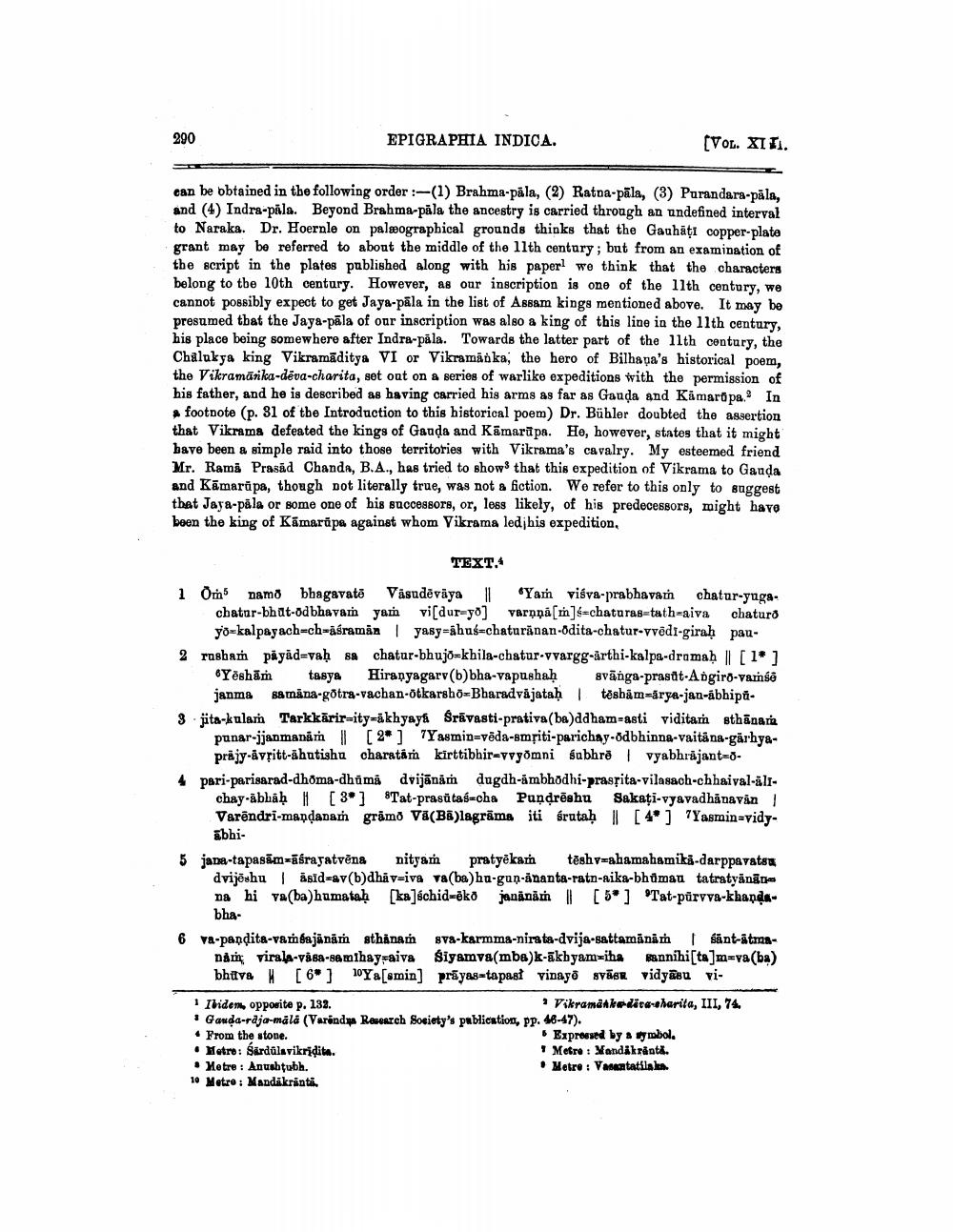________________
290
EPIGRAPHIA INDICA.
(VOL. XIII.
can be obtained in the following order :-(1) Brahma-pāla, (2) Ratna-pāla, (3) Purandara-pāla, and (4) Indra-pala. Beyond Brahma-pala the ancestry is carried through an undefined interval to Naraka. Dr. Hoernle on palmographical grounds thinks that the Gauhäţi copper-plate grant may be referred to about the middle of the 17th century; but from an examination of the script in the plates published along with his paper we think that the characters belong to tbe 10th century. However, as our inscription is one of the 11th century, we cannot possibly expect to get Jaya-pāla in the list of Assam kings mentioned above. It may be presumed that the Jaya-pāla of our inscription was also a king of this line in the 1lth century, his place being somewhere after Indra-păla. Towards the latter part of the 11th century, the Chalukya king Vikramaditya VI or Vikramāöka, the hero of Bilhapa's historical poem, the Vikramārika-dēva-charita, set out on a series of warlike expeditions with the permission of his father, and he is described as having carried his arms as far as Gauda and Kimaropa. In
footnote (p. 31 of the Introduction to this historical poem) Dr. Bühler doubted the assertion that Vikrama defeated the kings of Ganda and Kāmarūpa. He, however, states that it might bave been a simple raid into those territories with Vikrama's cavalry. My esteemed friend Mr. Rama Prasad Chanda, B.A., has tried to show that this expedition of Vikrama to Ganda and Kāmarāpa, though not literally true, was not a fiction. We refer to this only to suggest that Jaya-påla or some one of his successors, or, less likely, of his predecessors, might have been the king of Kámarapa against whom Vikrama led his expedition,
TEXT.
1 Om Damo bhagavató Väsudēvāya 1 'Yan visva-prabhavan chatur-yuga
chatar-bh at-odbhavam yam vi[dur-yo] vorņņā[m]ó-chaturas-tath-aiva chaturo
yö-kalpayach-ch-aframan yasy=khus=chaturanan-odita-chatur-vvedi-giraḥ pau2 rusbam pāyād=vaḥ sa chatur-bhujo-khila-chatur.vvargg-arthi-kalpa-dramah || [1]
Yēshām tasya Hiranyagarv(b)bha-vapushaḥ svānga-prasut-Adgiro-vamse
janma så måna-gðtra-vachan-otkarsho=Bharadvájataḥ těsbåm=arya-jan-abhipa. 3 jta-kular Tarkkārir-ity=åkhyaya Śrāvasti-prativa(ba)ddham-asti viditam sthanara
punar.jjanmanan [ 20 ] Yasmin=vēda-empiti-parichay-odbhinna-vaitana-gårhya
präjy-avritt-ahutishu charatam kirttibbir=vvyðmni subhro vyabhrājant-ðpari-parisarad-dhoma-dhimi dvijānām dugdh-ambhodhi-prassita-vilasach-chhaival-ali
chay-abhaḥ [3] Tat-prasūtas-cha Pundrëshu Sakați-vyavad hädavin Verēndri-mandanar gråmo V(BR)lagrama iti srutaḥ|| [4] Yasmin=vidy
abhi5 jana-tapasām=āśrayatvēna nityam pratyēkam teshvahamahamika-darppavates
dvijöshul isid-av(b)dhav-iva va(ba)ha-gun-ånanta-ratn-aika-bh mau tatratyänin na hiva(ba)humatah [ka]ichid=ēko janānā [5] Tat-pūrvva-khanga
bha
6 VA-pandita-vamajānam sthinam 868-karmma-nirata-dvija-sattamanan Isänt-atma
når virala-viba-B& mihayraiva siyamva(mbs)k-akhyam=iha onnihista]m=ya(ba)
bhuva # [6] Ya[smin] prāyas-tapast vinayo sãou vidyāsu vi* Ibiden opposite p. 132.
Vikramdakædita-sharita, III, 74, • Ganda-rdja mälä (Varándy Research Society's publication, pp. 18-47). • From the stone.
Expressed by a symbol. • Metro: Śärdülsvikridita.
"Metre : Mandåkrånta. • Metre : Anushtubh.
• Metre : Vasentatilaka. 10 Metre: Mandákränta.




